
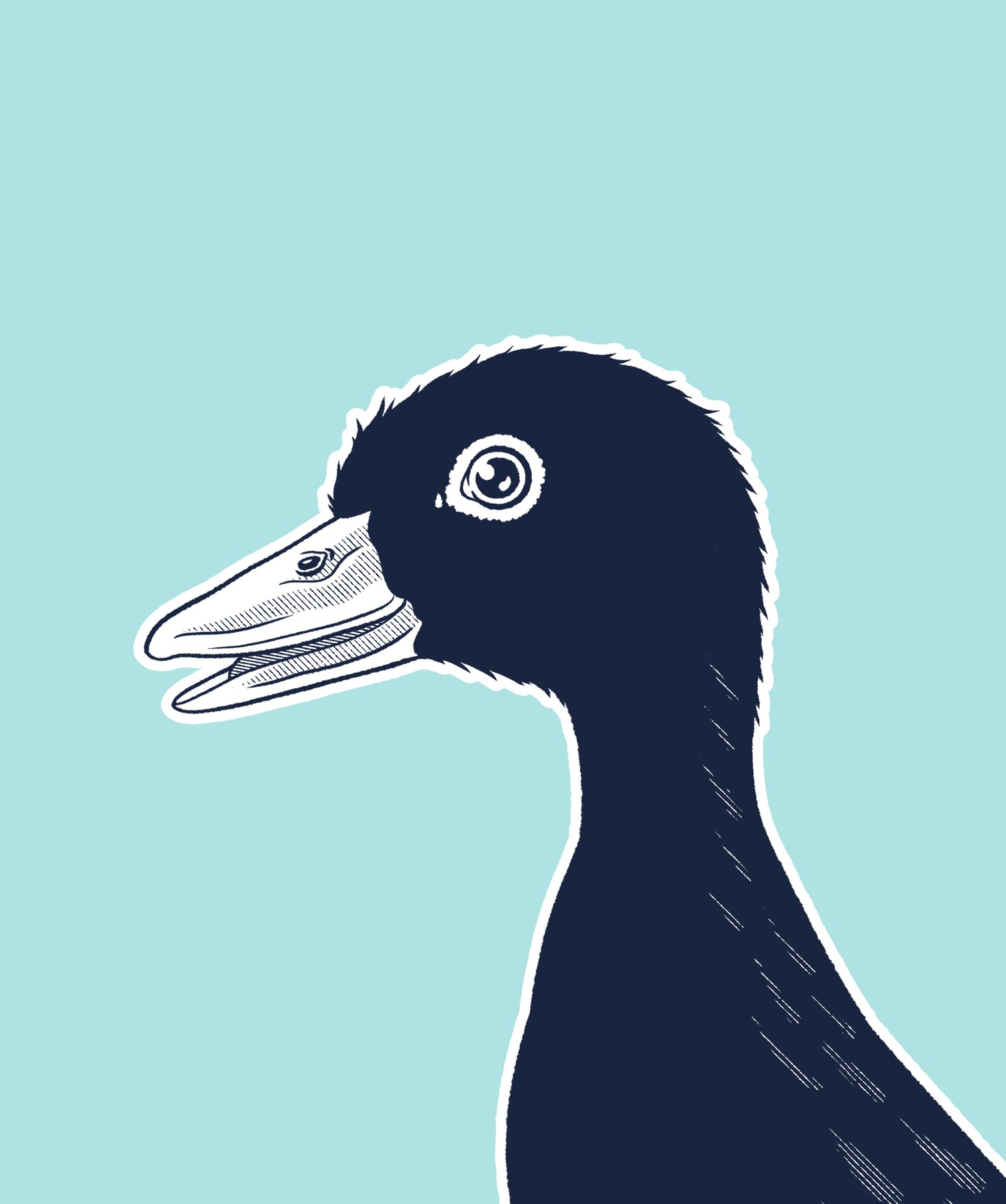
Hand rearing guide for ducklings
Introduction: Ideally, ducklings should be raised by their mother or a licensed wildlife rehabilitator, as this provides the best nutrition, warmth, and behavioural development. But emergencies happen, and sometimes you're the only one who can help.
This manual is here to guide you through the essentials of hand-rearing a baby duckling with care and confidence. Whether you've found a lone duckling or are stepping in temporarily, you’ll find practical advice to help give it the best possible start.
Disclaimer: This is a basic guide and doesn’t cover every issue that can arise when hand-rearing ducklings. It’s based on what’s worked best for us through experience and research. If you have any questions, feel free to email, we’re happy to help.
Checklist
Collapsible content
Brooder Setup
Brooder setups can take many forms, from professional incubators to DIY solutions made with whatever you have on hand. Below, I’ve outlined a few common options, but don’t be afraid to get creative and use your ingenuity to create a safe, warm space for your ducklings.
Cleaning Supplies
Cleanliness is key when raising ducklings. Keep paper towels, mild dish soap, white vinegar, and a safe disinfectant like F10 on hand. Clean food and water bowls daily, and change bedding often to prevent bacteria build-up.
Digital thermometer
Having a thermometer in your duckling brooder is key to keeping the temperature just right, especially in the first few weeks when ducklings can't regulate their own body heat. It ensures they stay warm, healthy, and stress-free as they grow.
Food Supplies
- Non medicated chick starter or a game bird crumble.
- Brewers yeast
- Bird Vitamins
- Veges and weeds
Heat Source
There are several heating options available, each with its pros and cons:
- Plant propagation heat mats/plates
- SnuggleSafe discs
- Incubators
- Wheat bags
- Hot water bottles
- Heat lamps
Soft Toys and Mirrors
This offers valuable enrichment. Mirrors and soft toys are especially important for solo ducklings, helping to reduce loneliness and promote natural behaviours.
Water and Food Containers
When raising ducklings, it’s important to choose water and food containers that are safe, easy to clean, and minimise mess. Shallow dishes or small poultry feeders work well for food, while water containers should be deep enough for them to dunk their bills but not so deep that they can climb in and get soaked. Gravity-fed waterers are ideal as they help keep water clean and reduce spills. Always ensure containers are stable and cleaned regularly to maintain good hygiene.
Brooder Set Up
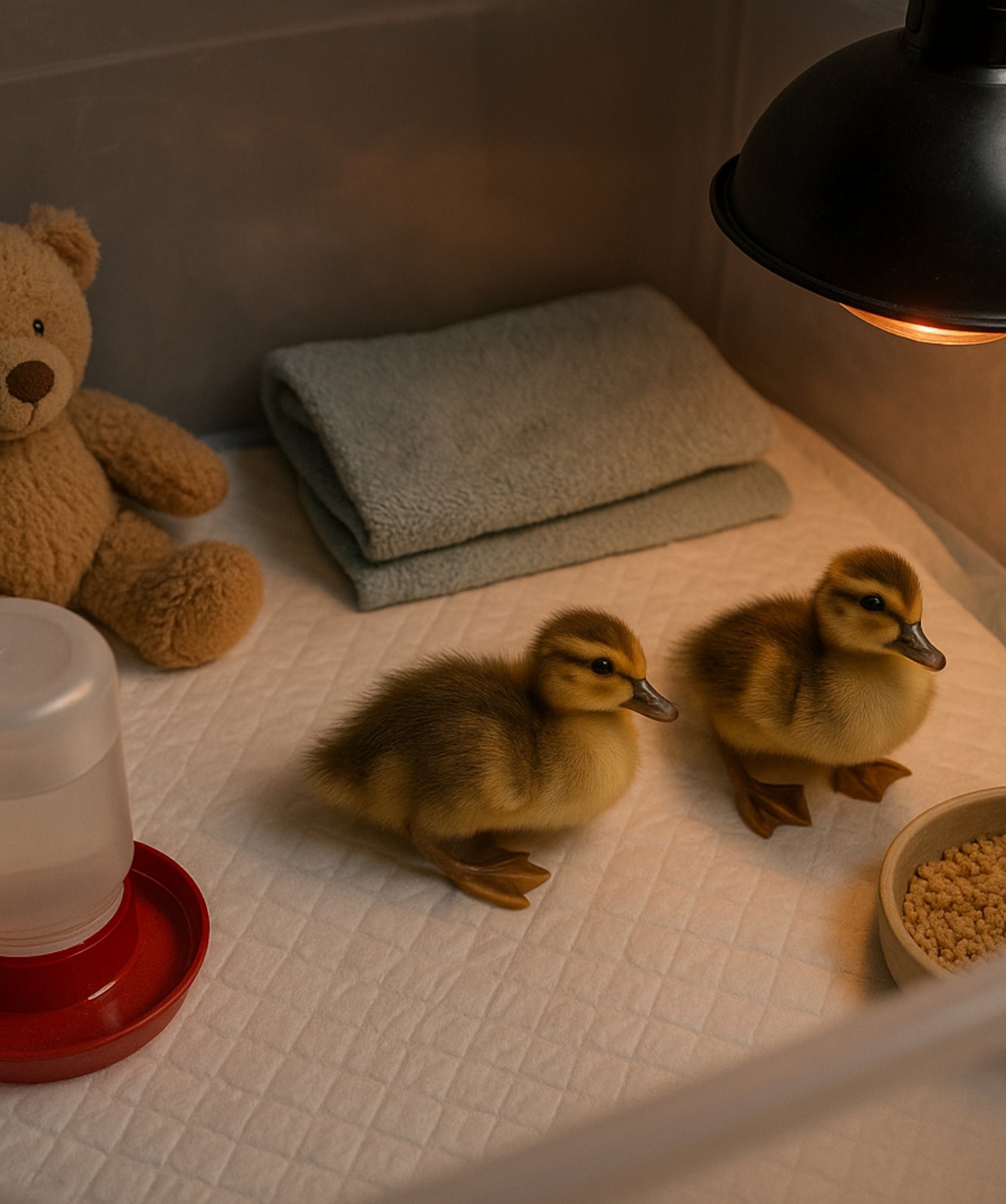
Temperature: Start at 32-35°C (90-95°F) in the first week. Reduce by 3°C each week until fully feathered (about 6 weeks). Use a heat lamp, brooder plate, snuggle safe or plant propagation heat mat. Ensure ducklings can move away if too warm.
Bedding: The best bedding depends on your setup and how often you can clean. Options include puppy pads, towels, paper towels, wood shavings, or newspaper—each with its own pros and cons. Choose a material that provides good traction, stays dry, and is easy to replace regularly. Be aware of fraying fabric edges, duckling can hyperfocus on this and get themself into mischief.
Space: A duckling's space needs will change as they grow. You may need to adjust or upgrade their setup several times to accommodate their increasing size and activity levels. We’ve listed a few ideas below to help guide you.
Simple to clean: Keep your setup simple and easy to clean, ducklings are messy by nature, and frequent cleaning will be essential to keep them healthy and comfortable.
Kmart has a wide range of options
-

90L Storage Tub with Window
Good first brooder, Easy to clean, cut air holes or add a mesh insert.
-

Large Pet Carrier
Good for short term use. Easy to clean.
-

Pet Carrier Foldable
Good size, not as easy to clean as other options.
-

Fold Up Crate
The lining can be taken out to turn this into a sade outdoor enclosure.
-

Pop Up Pen
A good all round pen with plenty of space for development. You can also cut the bottom out if needed.
-

Collapsible Pen
Great enclosure for transitioning ducklings to the outdoors. Use in combination with a more sheltered option.
Duckling Diet
-
Drinking water
Ducklings must have constant access to clean, shallow drinking water. It should be deep enough for them to fully submerge their bills to clear their nostrils and prevent blockages, but not so deep that they can swim or bathe in it. Shallow dishes are fine early on but may need changing multiple times a day, as ducklings tend to dirty their water quickly. A good gravity-fed waterer can help keep water cleaner for longer and reduce mess.
-
Commercial Diet (Week 1 - 3)
Note: For Paradise ducklings go straight to week 3 diet
Feed: Non-medicated chick or waterfowl starter crumble
Protein content: 19–22%
Important notes: Avoid medicated feeds (e.g., those containing monensin or other coccidiostats), which can be harmful to ducklings. Always check the label.
Some options available in NZ
- Chick starter crumble or mash (non medicated)
- Sharps duck starter crumble
- NRM Game bird crumble
- Westons game and quail crumble
-
Commercial Diet (Week 3 onwards)
Note: Paradise ducklings can start from here
Feed: Non-medicated chick or waterfowl starter crumble
Protein content: 16–18%
Important notes: Avoid medicated feeds (e.g., those containing monensin or other coccidiostats), which can be harmful to ducklings. Always check the label.
Some options available in NZ
- Weston Milling chook grow pellets
- NRM pullet grower pellet
- Mainfeeds chick grower
- Passwell Crumbles (Comes in 1kg bags)
- Chicken grower pellets (non medicated)
- Chicken grower crumble (non medicated)
-
Supplemental Extras
Fresh Greens (from 1 week old):
Introduce chopped greens and vegetables from one week of age. These provide natural vitamins and foraging enrichment. Good options include:
- Dandelion greens
- Silverbeet
- Cos lettuce (avoid iceberg)
- Chopped peas
- Grated zucchini
- Grated carrot
- Duckweed (if available)
Start with small amounts and monitor droppings. Introduce one new food at a time.
Multivitamins:
- Ducklings benefit from extra nutritional support during their rapid growth stage. A good Bird Vitamin added to their drinking water a few times a week can help ensure they’re getting essential nutrients, especially if they’re on a basic starter crumble.
Nutritional yeast flakes:
- Nutritional yeast flakes are a great natural source of B vitamins, especially niacin, which ducks need more of than chicks. Add about 1 tablespoon per cup of feed to support healthy leg and joint development. This helps prevent common issues like lameness or bowed legs in ducklings. You can mix it into dry feed or sprinkle it over moistened crumbles for better sticking.
Insects:
When introducing insects into your ducklings’ diet, variety and moderation are key. While insects are a great source of protein and enrichment, not all are equal in nutritional value. Mealworms, for example, are commonly fed but are very high in fat and low in calcium, which can lead to developmental issues such as angel wing or poor bone growth if overfed. It's best to offer them only occasionally and in small amounts.
Instead, consider a mix of more balanced options like black soldier fly larvae, crickets, or silkworms—these provide better calcium-to-phosphorus ratios and are gentler on growing bodies.
For a great range of bird-safe insect options, check out Insect Direct, a New Zealand supplier with a variety of dried and live insects to suit your ducklings' needs.
-
Important note: Scratch mixes (feeds containing mixed grains, pellets, and corn pieces) are not recommended as a primary diet for ducks. Ducks are selective feeders and will often pick out the tastier bits, leading to nutritional imbalances. These mixes should only be offered as an occasional treat or supplement—ideally making up no more than 5% of their total diet.
Short Term Duckling Diet
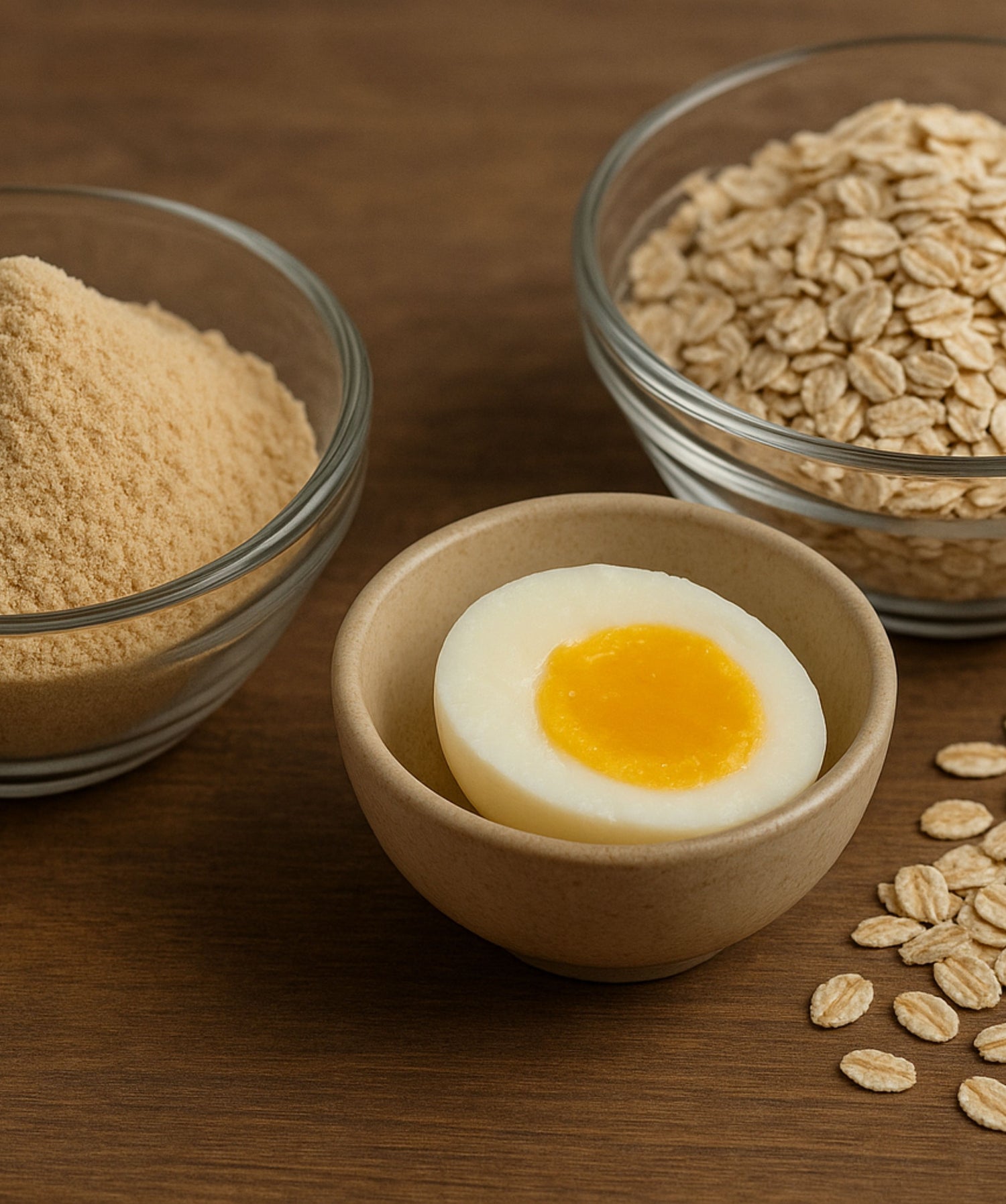
Home made recipe
This homemade mix is a helpful short-term option if you’re caught without commercial duckling feed. It’s designed to get you through in a pinch, but should only be used temporarily until a proper, nutritionally balanced starter feed can be provided.
Recipe:
- 1 part rolled oats (quick oats)
- 1 part finely mashed boiled egg (including yolk and white)
- ½ part defrosted mashed peas
Optional Nutritional Boosters (if available):
- A sprinkle of Nutritional yeast or B-vitamin supplement
- A few drops of fish oil or flaxseed oil or ground flaxseed (for omega-3s)
- Chopped leafy greens (e.g., spinach, silverbeet, or dandelion)
Swimming
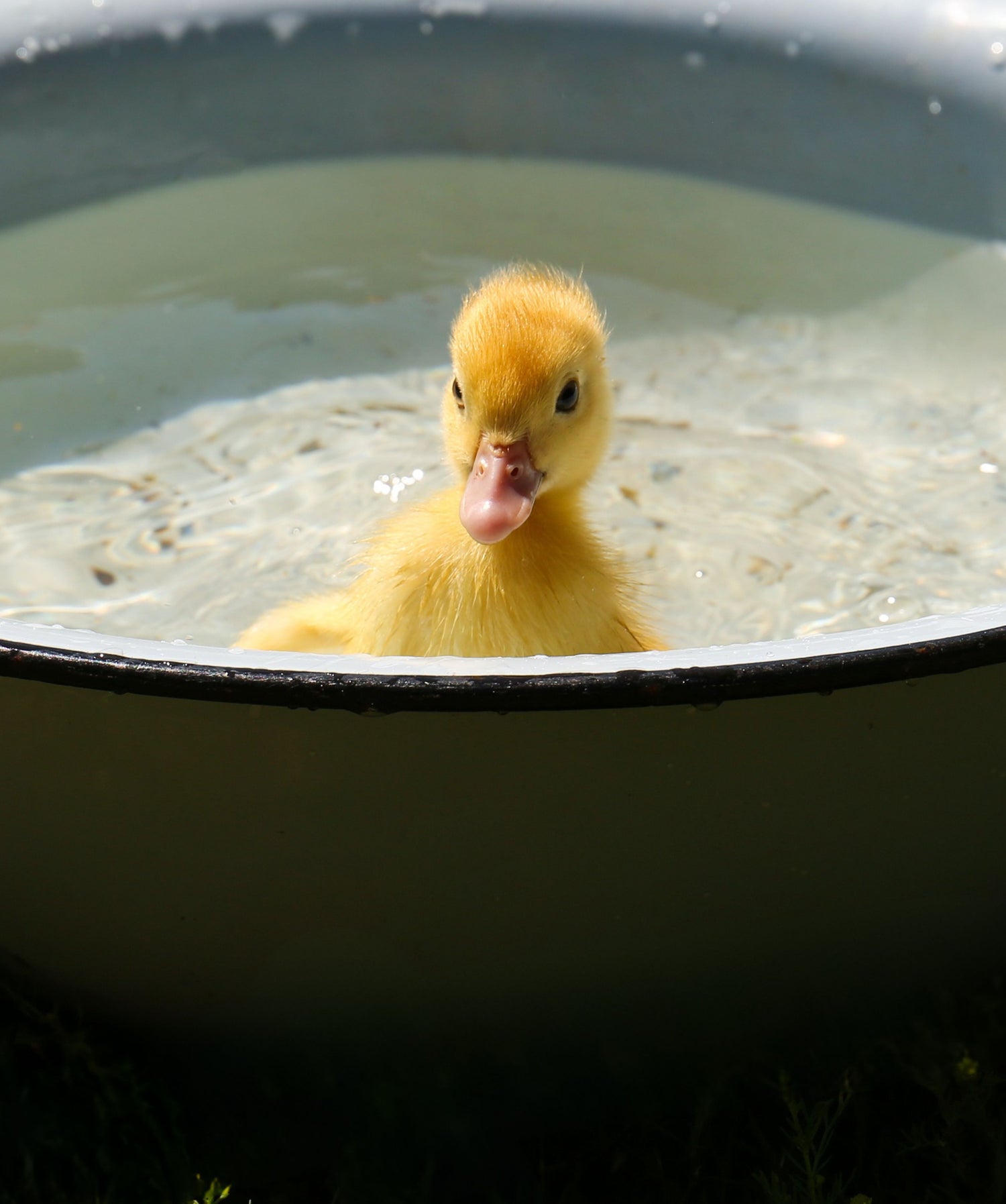
Ducklings can begin short, supervised swims from around one week of age, ideally in lukewarm water (around 28–32°C).
Keep sessions brief at first and always supervise closely. Use a shallow container with safe, easy entry and exit points. Never leave ducklings unattended in water.
After swimming, provide a warm, dry area where they can rest and preen,this is vital for feather development and to prevent chilling.
As ducklings grow and begin producing their own waterproofing, swim time can be gradually extended.
For added enrichment, you can occasionally include soft items like mushed peas or a sprinkle of their crumble in the water to encourage natural dabbling behaviour.
Transitioning to the Outdoors
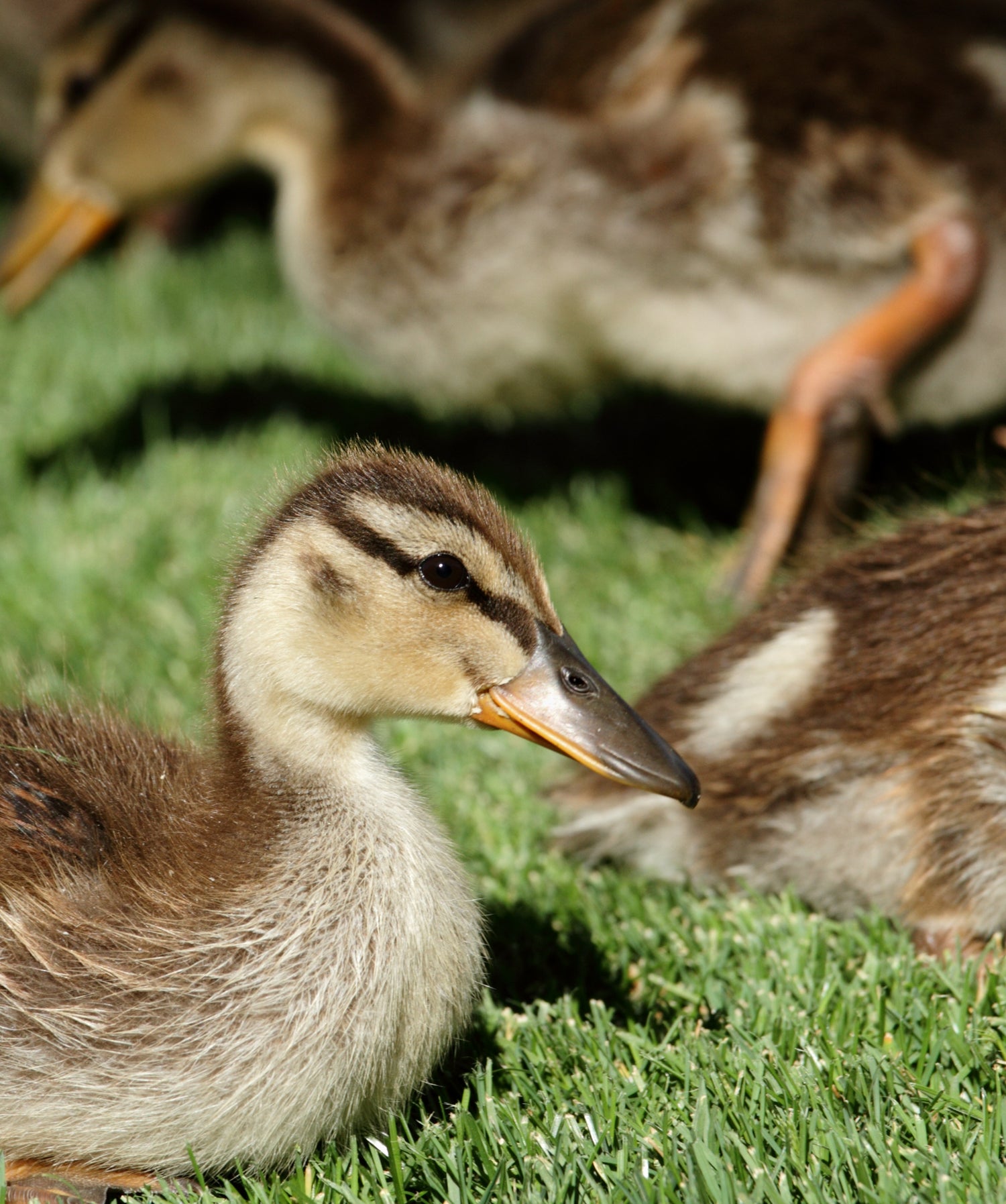
Timing: Ducklings can be transitioned outdoors once they are fully feathered—typically around 6 to 8 weeks of age—and only if the weather is mild, with no risk of chilling. If temperatures drop below 10°C (especially at night), provide additional heat or wait until conditions improve.
Shelter: Ensure they have access to a secure, predator-proof shelter with dry, clean bedding (such as straw or wood shavings), proper ventilation, and protection from wind, rain, and extreme sun. The shelter should be fully enclosed at night and provide enough space for them to move freely without overcrowding.
Outdoor Foraging: Gradually introduce ducklings to the outdoors in short, supervised sessions. Allow them to explore grass, bugs, and shallow water areas during the day, but always ensure they have access to shade and clean water. Start with brief foraging periods and build up their exposure slowly to help them adapt to temperature changes and the natural environment without stress. This helps strengthen their immune systems and encourages natural behaviours like foraging and bathing.
Release: Ducklings should only be released once they’re fully feathered and flight-capable, for mallards this is typically 8–10 weeks (sometimes up to 12). They must be waterproof, self-feeding, maintaining weight, and coping outdoors. Keep handling low to avoid imprinting, and release at a safe water site in settled weather, ideally at dawn/dusk with their siblings.
Socialisation and Behaviour
-
Humanising: Limit excessive handling, as ducklings can easily imprint on humans. While some interaction is unavoidable, too much can reduce their ability to adapt to life outdoors or integrate with other ducks, especially if the goal is eventual release or natural behaviour.
-
Enrichment: Provide safe, clean enrichment items to stimulate natural behaviours like foraging, preening, and social interaction. Suitable options include mirrors (to reduce loneliness in solo ducklings), soft toys for snuggling, small balls for gentle play, and clean, smooth stones for pecking and exploration. Be sure to clean enrichment items regularly to minimise the risk of disease or contamination.
-
Companionship: Ducks are highly social animals and thrive in the company of their own kind. It’s always best to raise at least two ducklings together to prevent loneliness, stress, and behavioural issues. Ideally, keep ducklings of similar age and size together, as large age gaps can lead to bullying or injury. Matching their developmental stages helps ensure safer interactions and a more harmonious flock.
-
Bullying: Monitor closely for signs of bullying, as some ducklings may begin pecking or pulling at the wing tips or tails of their flockmates. This behaviour can escalate quickly, sometimes leading to open wounds or bleeding. If bullying is observed, separate the aggressor early to prevent injury and stress within the group.
Common Health Issues
Collapsible content
Angel Wing
Angel wing is a musculoskeletal deformity that affects growing ducklings, typically between 3 to 8 weeks of age. It causes the last joint of the wing to twist outward, making the flight feathers stick out laterally rather than lying flat against the body. This condition is largely cosmetic in domestic ducks (which usually don't fly), but if left untreated it becomes permanent.
The primary cause is rapid growth, often driven by diets too high in protein, carbohydrates, or overall calories, especially in commercial poultry feeds not formulated for waterfowl. Imbalanced calcium-to-phosphorus ratios and vitamin deficiencies (like vitamin D or E) may also contribute.
If caught early, angel wing can often be corrected:
- Wrap the wings gently against the body using vet wrap or similar, leaving space for breathing and movement.
- Adjust the diet: lower the protein to 14–16% and reduce calorie-dense treats like bread or grains. Introduce more leafy greens and roughage to slow growth naturally.
Once the wing bones harden, the condition becomes irreversible, so early intervention is key. While angel wing doesn’t usually affect quality of life in backyard ducks, prevention through balanced feeding is the best approach.
Botulism
Botulism is caused by toxins produced by bacteria (Clostridium botulinum) that thrive in decaying organic matter, particularly in warm, stagnant water. Birds affected may appear weak or paralysed and often lose the ability to hold their heads up.
Treatment involves immediate supportive care: administering fluids, activated charcoal to help bind the toxin (if caught early), and keeping the bird supported, upright, and clean.
Prevention is key,ensure water sources are fresh and free from stagnation, rotting vegetation or animal remains, and keep enclosures well-drained and hygienic.
Bumblefoot
Foot problems in ducks can stem from several causes, and it’s important to distinguish between mild pad irritation (such as burns from droppings or hard surfaces) and more serious infections like bumblefoot. Bumblefoot typically develops when small injuries—often from sharp edges, rough flooring, or constant pressure—allow bacteria to enter the footpad. Without early intervention, this can progress into a painful, swollen, and sometimes ulcerated infection.
Ducks naturally thrive on soft, damp ground, which cushions their feet and helps prevent pressure damage. If your ducks are housed indoors or on hard surfaces, aim to provide soft, non-slip flooring such as rubber mats, deep straw, turf, or padded bedding. Also be sure to keep areas clean, as constant exposure to soiled bedding can cause chemical burns and weaken skin integrity.
At the first signs of redness, calluses, or limping, start supportive care with warm Epsom salt soaks and a bird-safe balm. Catching the issue early can prevent the need for more intensive treatment.
For detailed guidance on identifying and treating bumblefoot, visit our Encyclopedia Entry on Bumblefoot
Infectious Diseases
Wild waterfowl can carry parasites, bacteria, and viruses that may not always make them sick but can be passed on to other vulnerable ducklings and domestic birds. These pathogens can be spread through contaminated human contact (hair/clothes/hands), water, droppings, feed, or direct contact, and may lead to serious illness or death in young birds with immature immune systems.
To reduce the risk of disease transmission, it’s essential to prevent contact between wild and domestic birds. Keep duckling brooders and outdoor enclosures secure and covered to avoid exposure to wild birds and their droppings. Always provide clean drinking and swimming water, and change it frequently to prevent the growth of harmful bacteria.
Good hygiene practices:
- washing hands before and after handling ducklings.
- quarantining the obviously sick.
- dealing with the sickest birds last.
- changing clothes or wearing gloves/coveralls.
- disinfecting brooders, feeders and drinkers regularly.
- keeping bedding dry and clean.
These are vital for keeping your ducklings healthy.
If you're bringing in rescued or found ducklings, quarantine them for at least a few days before introducing them to others, and monitor for signs of illness. Practising strong biosecurity protects not only your ducklings but also the wider community of birds
Nutritional Deficiency
Ducklings grow rapidly and require a well-balanced diet to support healthy development. Deficiencies, especially in niacin (vitamin B3), can lead to leg weakness, stunted growth, and other serious health issues. To prevent problems, feed a waterfowl-specific starter crumble and consider adding a high-quality, water-soluble Bird multivitamin or a small amount of brewer’s yeast to their feed. These simple additions can help ensure your ducklings get the nutrients they need to thrive.
Trauma
Injuries from fights, fences, or panic are common. Remove hazards and isolate aggressive birds. Treat wounds, bleeding, or swelling promptly with vet care and topical antibiotics if needed.
Splayed Legs
Slipping on smooth surfaces can cause leg ligaments to stretch. Splinting the legs early can correct this. Use firm, non-slip footing and keep legs in a natural position while healing.
Watch for signs of illness such as lethargy, reduced appetite, laboured breathing, or limping, as these can indicate underlying health issues. If you notice abnormal droppings, persistent weakness, or sudden changes in behaviour, it's time to seek help. Having a vet familiar with waterfowl on hand is always a good idea in case of emergencies.
References
- Duerr, Rebecca S., and Laurie J. Gage, editors. Hand-Rearing Birds. 2nd ed., Wiley-Blackwell, 2020.







